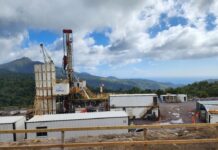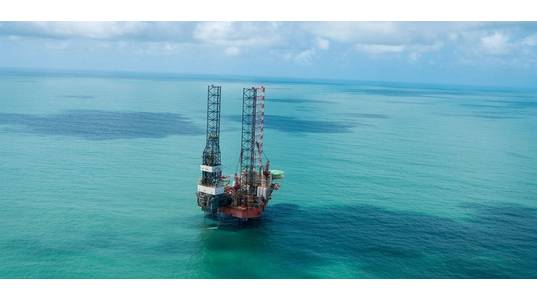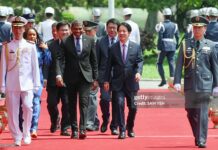News Americas, NEW YORK, NY, Tues. Aug. 10, 2021: Suriname, like Guyana, has just discovered billions of barrels of recoverable oil offshore its coast. This has attracted a flurry of international investors seeking to capitalize on the sudden boom in its oil & gas sectors. The mass of foreign attendees at the Suriname Energy, Oil and Gas Summit, (SEOGS), is a sign of the spotlight shining on the small Latin American country with nearly 600,000 people. In a recent tender to develop eight of the country’s offshore blocks, oil majors Qatar Petroleum, TotalEnergies and Chevron were the winners. However, despite the promise of the newfound resources, Suriname had the second worse economy in Latin America in 2020, only behind the authoritarian Venezuela. With a 13% GDP decline, high levels of inflation, and a fifth debt restructuring in the past 15 years, the country’s macroeconomic prospects remain dire.
In April, the newly elected center-left President, Chan Santohki, reached a U$690 million financing agreement with the IMF that includes necessary austerity measures to put the country back on a sustainable economic path. Although the details have not been fully disclosed, energy subsidies[1] provided to the state-electricity company will likely be removed. A fuel tax of 1 Surinamese dollar per gallon, will also likely be implemented. These measures will be poorly received by the population and may cause social unrest.
The IMF deal also caused an uproar among bondholders as it recommended that Suriname exclude its unproven oil reserves in its debt sustainability and macroeconomic analysis. The Suriname Eurobond creditors, a bondholder group composed of leading financial players such as Franklin Templeton and Eaton Vance, see the oil resources as a fundamental aspect of the country’s capacity to repay its debt. Hence, in June 2021, they trigged a “termination” clause that will reinstate debt payments if the IMF deal is not reconsidered.[2]
Since the Surinamese government is considering issuing $400mn in bonds tied to oil production, with a 5% coupon rate, it is reasonable for the country’s debt repayment capacity to factor in estimated oil reserves—not just proven finds. [3]If the repayment amount needs to be adjusted in the future, either up or down based on new proven figures, independent mechanisms should be implemented to allow the flexibility to do so.
The creditors don’t have to look far to see how an unexpected influx of billions of dollars can improve the government’s capacity to repay debt. In nearby Puerto Rico, an island that is part of the United States, over U$100 billion in federal disaster funds and Covid-19 relief money has helped the government post record budget surpluses. These funds will help the territory repay some of its $74 billion in outstanding obligations.[4] As in Puerto Rico, it is fundamental for the Surinamese government to also do its part to improve its people’s wealth and quality of life. AMI recommends the following three steps:
#1 Create a Sovereign Wealth Fund (SWF) that works
Like Guyana, Suriname is going to need a well-structured, transparent SWF to invest its oil funds while ensuring savings for future generations.
Learning from Guyana: Guyana’s Natural Resource Fund, implemented by the Granger administration, is domiciled in a U.S.-dollar based New York Federal Reserve Account. This has kept the funds in a highly reputable institution and prevented any foreign exchange fluctuations. The fund also allows for a greater percentage of spending at the beginning of its tenure, allowing for immediate investment in much-needed societal improvements. It limits the annual spending to the greater of the two: i) the five-year average of non-petroleum revenues or ii) three percent of the project balance of the fund.
The fund, however, is being modified by the current Ali administration while first oil has already started flowing. The Ali administration has suggested that the fund might model Kazakhstan’s sovereign wealth structure, an authoritarian and corrupt state, to allow for greater spending. [5]
What Suriname can do instead: Although Suriname already established a Savings and Stability fund for its mining royalties, the amount of wealth generated from its oil finds will be exponentially larger. The current Savings and Stability Fund allows for the government to spend up to 15% of its annual funds, which is significantly higher than the three percent cap set by the successful Norwegian SWF. Understandably, a 3% limit might be slightly too low for a country with underdeveloped infrastructure such as Suriname, but a 15% ceiling substantially limits the country’s ability to grow its wealth. A more moderate percentage needs to be implemented to allow for the current society to prosper while conserving future cash.[6]
To that end, Suriname needs to pass a new law creating a fund specifically for its oil resources that is professionally managed by an independent body with no political connections. The law needs to establish clear thresholds on the amount that can be spent annually and strict accountability measures that ensure the funds are being spent transparently. It is also vital for there to be a clear delineation between the fund’s managers and politicians, making it less likely for its oil funds to be misused and exploited. President Santokhi’s appointment of his wife to the supervisory board of Staatsolie, the state-owned company, signals that Suriname is heading down the wrong path. The people must demand change before it’s too late.[7]
#2 Passing a local content law and diversifying its economy
Learning from Guyana: As first oil is produced only in 2025, Suriname has a tremendous opportunity to look at its neighboring Guyana to see what has and what has not worked in its oil development. Outside of extractive sectors, such as mining, Guyana has an agriculture and services sector that is not highly developed. The country’s low levels of economic diversification will make it difficult for the country to absorb future oil price shocks. Guyana has also failed to implement many laws prior to first oil that would have allowed for greater local participation and more investor clarity. Its local content policy, for example, is still under consultation and will likely be under review for many months to come. Guyana’s new SWF law, to manage its oil monies, will likely only be approved in 2022. [8]
What Suriname can do instead: Having these frameworks in place before first oil will be fundamental for Suriname to grow in a healthy manner. Consulting key private and public stakeholders, as well as the local communities, will allow for the development of realistic thresholds that can be fulfilled by the country’s current resources on the ground.
To avoid the “Dutch disease,” ironically named after Suriname’s colonizers after their manufacturing sector declined following the discovery of a vast amount of natural gas, Suriname must also diversify its economy beyond the oil & gas sector. Agriculture, real estate, manufacturing, and mining are some of the key sectors that must be incentivized both in terms of fiscal and regulatory frameworks.
Domestic and regional participation will be important in the long-term, but even more so, will be the arrival of global international players that have the expertise and capacity to handle the uptick in economic developments. A local content policy that requires reasonable participation of local labor and companies, while simultaneously providing an investor-friendly regulatory requirement for foreign investors, will be fundamental in the industrialization and diversification of the economy.
#3 Eliminate systematic corruption
Learning from Guyana: The last and most complex factor involves the elimination of the systematic corruption present both in Suriname and Guyana. A culture of bribes, patronage and nepotism is the greatest danger to both country’s prosperity. Racial and political infighting in Guyana has also prevented the country from moving forward at a faster speed as projects have been delayed and elections have been disputed.
What Suriname can do instead: First, a collaborative political approach in Suriname will avoid some of the bureaucratic interruptions seen in Guyana that are especially harmful for an economy growing at such a rapid pace. Second, in terms of corruption, establishing international and domestic accountability bodies, in addition to implementing the necessary framework that prevents the misuse of oil funds, is one solution. Independent news outlets and a more robust educational system is also strongly correlated with transparency levels. Although Guyanese leaders have publicly said a lot of the right things, in practice, few actions have been implemented so far. Suriname must take note to avoid committing the same mistakes.
[1] Starting at 10% and reaching up to 75% of the total electricity cost
[3] AMI Interviews
[6] Economist Intelligence Unit
[7] AMI Interviews
[8] AMI Interviews










